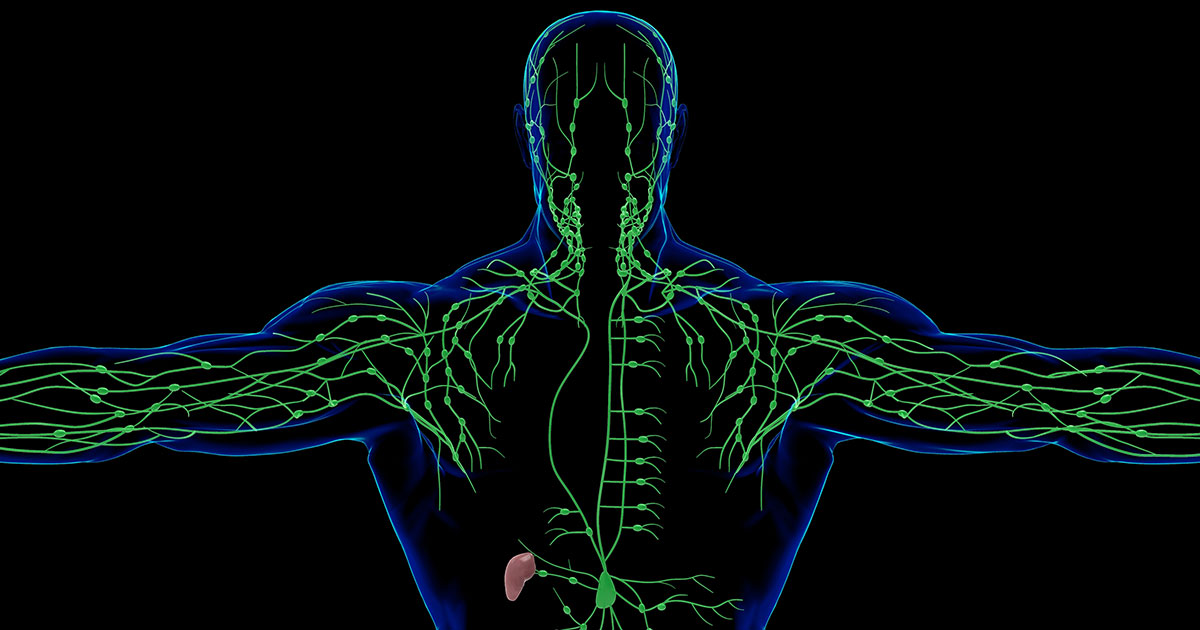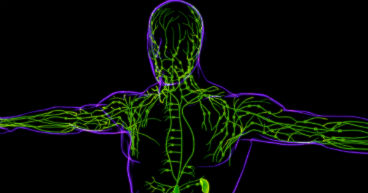
Lymph nodes are no bigger than a baked bean, but they’re powerful weapons in the body’s defense against disease and infection. These ovoid glands are scattered throughout the body, helping filter impurities in the blood. Perhaps their mightiest role, though, is producing B-cells, lymphocytes that make specialized proteins called antibodies to attack foreign invaders.
Sometimes, you may notice swollen lymph nodes in your neck, armpits or groin. This is usually a sign that your immune system is producing an abundance of B-cells to help your body fight off infection. But swollen lymph nodes may also signal more serious conditions.
In this article, we’ll explain when swollen lymph nodes may indicate more than a common infection. Topics include:
- How do you know if swollen lymph nodes are caused by a serious condition?
- When should you call a doctor?
- Which tests may be used to determine why they’re swollen?
- Which cancers are associated with swollen lymph nodes?
- What is a sentinel lymph node biopsy?
- What is lymphedema?
If you’ve been diagnosed with a blood cancer, such as lymphoma, leukemia or multiple myeloma, and are interested in a second opinion on your diagnosis or treatment options, call us or chat online with a member of our team.
How do you know if swollen lymph nodes are due to a serious condition?
The body has more than 600 lymph nodes in clusters in the neck, armpits, groin and torso, between the lungs, and in the belly, and around the bowels. They’re part of the body’s lymphatic system, which also includes the spleen, tonsils and adenoids. The lymph nodes scattered throughout the body act to filter out harmful, foreign cells like viruses and bacteria as well as cancer cells.
Lymph nodes are connected by vein-like vessels that carry lymph, a clear, watery liquid made up of cells called lymphocytes that help the lymphatic system protect the body from germs and impurities. The fluid flows through the vessels and the lymph nodes, where it’s filtered and then released back into the bloodstream.
When you have a bacterial or viral infection like a cold, the flu, an ear infection or an abscessed tooth, your lymphatic system kicks into action, producing lymphocytes to fight the infection and causing the lymph nodes to swell. If you’re aware you have an infection like strep throat or an infected cut, for instance, you may recognize that the swollen lymph nodes are related to the infection. The lymph nodes may swell in an area that corresponds to the infection. For instance, an abscessed tooth may cause the lymph nodes in the neck to swell as the lymphatic fluid from the infection site drains through the nodes in that area, just as an infected cut on your leg may make the lymph nodes in your groin swell.
Immunizations, including the COVID-19 vaccine, may cause swollen lymph nodes and usually disappear after a few days. Certain medications, like those to prevent malaria, may also cause lymph nodes to swell.
You may have swollen lymph nodes and not be able to pinpoint the cause or location of the infection without the help of a doctor, such as in the case of mononucleosis, shingles, a sexually transmitted disease or an autoimmune condition, such as lupus or rheumatoid arthritis.
Sometimes, swollen lymph nodes are a sign of a more serious condition—like cancer. Some characteristics may help distinguish worrisome swollen lymph nodes from those just doing their job defending the body against infection.
“If you can feel a lymph node that’s bigger than a half-inch, or if you can’t move it with your finger, that’s more worrisome,” says Beomjune B. Kim, MD, Head and Neck and Microvascular Reconstructive Surgeon at City of Hope Atlanta.
Also, if it feels firm, that may cause concern, he says. Here’s how to tell the difference between a normal and abnormal lymph node:
- A normal lymph node feels like pressing on the tip of your nose.
- An abnormal lymph node feels harder, like pressing on your chin.
When should you call your doctor?
Generally speaking, call your doctor if:
- You have any symptoms that concern you.
- You feel may need medical attention for any reason.
- You can’t think of or discern a reason why your lymph nodes are swollen.
Also be aware of other persistent symptoms you may be experiencing along with the swollen lymph nodes, such as:
- Fever
- Chills
- Night sweats
- Loss of appetite
- Unexplained weight loss
- Non-healing sores in the mouth
- Ear pain
- Cough that produces blood
- Blood-tinged mucus
Other symptoms that may warrant a trip to your doctor include:
- Skin that’s red, irritated or warm around the lymph node
- Bleeding, non-healing sores
- Fatigue
- Trouble swallowing
- Coughing or shortness of breath
- Abdominal pain
- Feeling full after eating just a small amount of food
“Whenever an adult older than 40 can feel a lymph node in the neck, that’s a worrisome sign,” says Dr. Kim.
Which tests may be used to determine why the lymph nodes are swollen?
To determine the cause of your swollen lymph nodes, your doctor will begin with a physical exam, feeling the lymph nodes, examining you for other signs of infection and evaluating your general health. Most likely, the doctor will order a complete blood count (CBC) to help gather information about your infection-fighting white blood cells. Depending on your symptoms, the doctor may also request imaging tests, such as:
- X-ray
- Ultrasound
- Computed tomography (CT) scan
- Magnetic resonance imaging (MRI) scan
- Fluorodeoxyglucose with positron emission tomography (FDG-PET) to help spot (or rule out) lymphoma and other cancers
Tests to rule out an infection like HIV, tuberculosis, syphilis or the Epstein-Barr virus may also be performed.
If these tests don’t reveal a reason for your swollen lymph nodes, your doctor may want to perform a biopsy to take a sample of the lymph node tissue for a pathologist to examine under the microscope.
Several types of biopsy may be performed, including:
Fine needle aspiration biopsy: Similar to donating blood, the doctor uses a fine, hollow needle to extract some fluid and cells from the lymph node.
Core needle biopsy: A larger hollow needle is used to remove a small chunk of tissue. This procedure typically requires local anesthesia.
Both types of biopsies take about 15 to 30 minutes, after which you’ll be able to return to your regular activities.
An open biopsy is more like surgery since the doctor makes an incision in the skin to remove part or all of the lymph node, then sutures the wound closed. This procedure may be performed under local or general anesthesia.
What cancers are associated with swollen lymph nodes?
If the pathology report detects cancer in the lymph nodes, it either started there or spread from another cancerous tumor in the body.
Cancer of the lymph nodes is call lymphoma, which is a type of blood cancer. Lymphoma is categorized by a number of types, but the most common are Hodgkin lymphoma and non-Hodgkin lymphoma, differentiated by the type of lymphocyte cells involved. Non-Hodgkin lymphoma, which is more common, is found in lymph nodes anywhere in the body. Most cases of non-Hodgkin lymphoma are diagnosed in advanced stages.
Hodgkin lymphoma usually forms the lymph nodes in the chest, armpits or neck and, because it’s likely to be diagnosed early, patients generally have positive outcomes.
Cancer cells found in lymph nodes may also have broken away from another cancer elsewhere in the body and traveled there through the bloodstream or lymphatic system. Most of these stray cancer cells die before they can start growing somewhere else. But if the cells spread to a new organ or lymph node, the cancer is considered metastatic. Metastatic cancers often cause swollen lymph nodes near the tumor, as the body tries to do its job fighting off the disease.
What is a sentinel lymph node biopsy?
If the pathology report analysis suspects metastasis, the doctor may perform a sentinel lymph node biopsy to confirm it. The sentinel lymph node is the first node cancer cells are likely to spread to from the primary tumor. If the sentinel lymph node shows no signs of cancer, it’s likely that the cancer has not metastasized—a conclusion that may help the patient avoid more extensive lymph node surgery.
This procedure is regularly used for melanomas and breast cancers to help determine whether and to where the cancer has spread, Dr. Kim says. To locate the sentinel lymph node, the doctor will inject a dye or radioactive tracer into the tumor, then observe which node, or nodes, the dye travels. to.
“We surgically remove that lymph node and evaluate it to see whether there’s any cancer there,” Dr. Kim says. “If it’s positive, we know the cancer has spread to the lymph node. At that point, we can proceed to remove the entire lymph node basin in a lymph node dissection. Or we can decide to give radiation therapy or systemic chemotherapy to treat the metastasis, depending on which cancer it is.”
What is lymphedema?
When many lymph nodes are removed, as in a sentinel lymph node biopsy or lymph node dissection, that area of the body no longer has a way to drain lymphatic fluid. The resulting buildup of fluid is called lymphedema. The more lymph nodes removed, the more likely the patient will experience lymphedema.
“Usually, people can regenerate lymphatic vessels within one or three years,” Dr. Kim says. “Lymphedema improves over time.”
But the condition is bothersome for lots of patients, he says, causing discomfort and, in some cases, difficulty swallowing and even numbness if nerves were damaged during the lymph node removal. Some patients who have lymph nodes removed in the neck or armpit area experience shoulder weakness that may require intensive physical therapy, Dr. Kim says.
“Most of these complications or side effects are temporary,” he says.
If you’ve been diagnosed with a blood cancer, such as lymphoma, leukemia or multiple myeloma, and are interested in a second opinion on your diagnosis or treatment options, call us or chat online with a member of our team.


